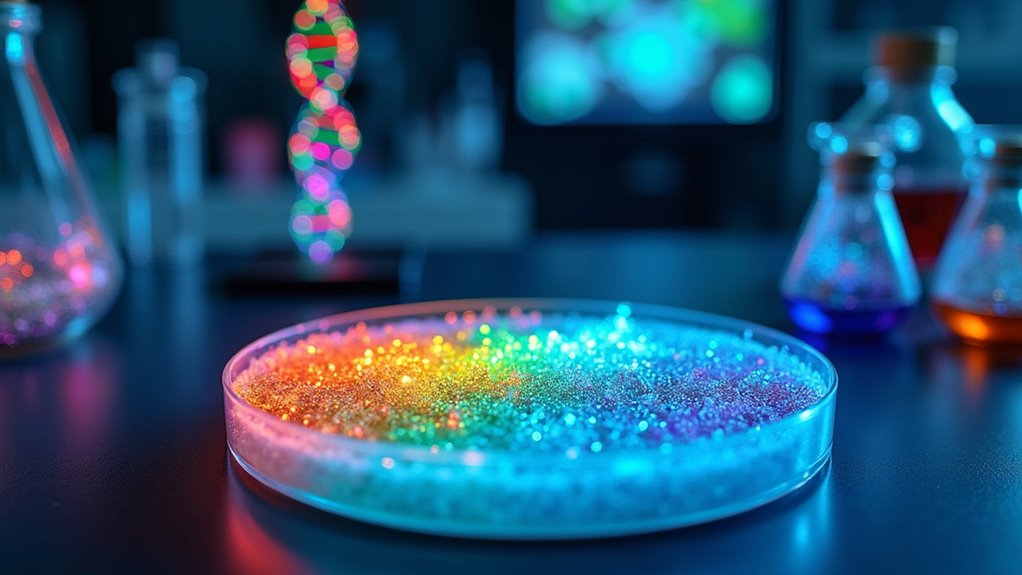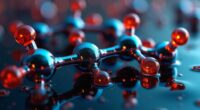Medicinal chemistry combines chemistry, biology, and technology to design, develop, and optimize drugs that effectively treat diseases. Scientists identify targets like proteins or genetic material, then create molecules that fit these targets precisely, often using computer models to predict interactions. They refine these compounds for safety, efficacy, and delivery, overcoming biological barriers along the way. If you want to understand how this complex process works step by step, there’s more to explore ahead.
Key Takeaways
- Medicinal chemistry involves designing small molecules that specifically interact with biological targets like proteins.
- Scientists use computer models to visualize drug-target interactions, ensuring proper shape and charge fit.
- The process includes optimizing chemical structures for potency, safety, and favorable pharmacokinetic properties.
- Researchers employ high-throughput and virtual screening to rapidly identify promising drug candidates.
- Targeted modifications and delivery systems improve drug effectiveness and minimize side effects.
The Foundations of Drug Design

Understanding the foundations of drug design is essential for developing effective and safe medications. You focus on how small molecules interact with biological targets like proteins, aiming to modify their functions. Computer modeling helps you visualize and predict these interactions, guaranteeing drugs fit well with their targets in shape and charge—these are called complementary structures.
Molecular mechanics and dynamics estimate how strongly drugs bind, which influences their effectiveness. Designing drugs with high affinity and selectivity ensures they target specific biomolecules, reducing side effects. These computational techniques allow for precise predictions of binding interactions, streamlining the drug development process. Additionally, the use of quantitative structure-activity relationship (QSAR) models helps optimize drug candidates by correlating molecular features with biological activity.
You also consider physicochemical properties, absorption, distribution, metabolism, excretion (ADME), and toxicity early on. These principles guide you in creating molecules that are both effective and safe, laying the groundwork for successful drug development.
Approaches to Discovering New Medications
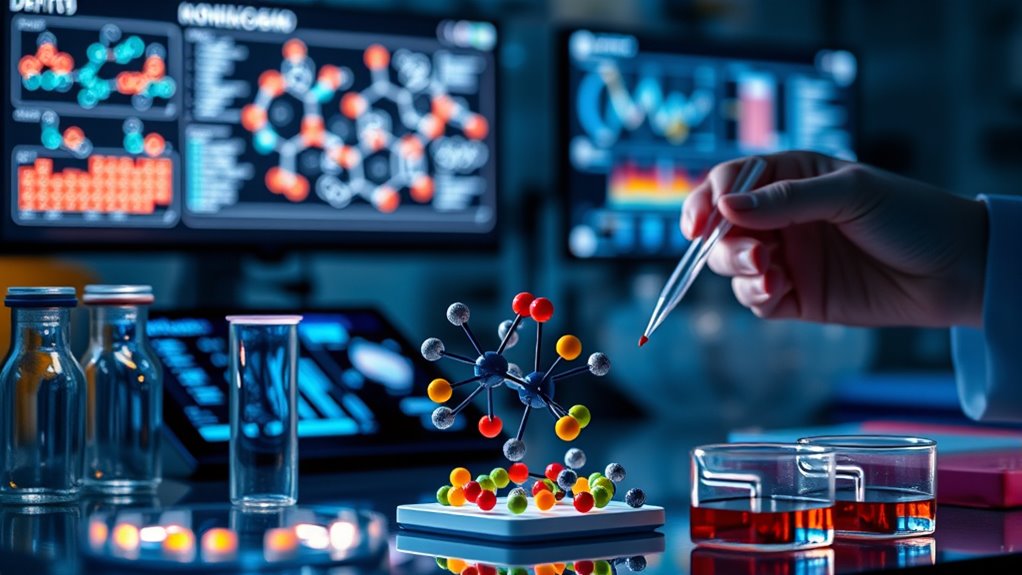
Discovering new medications involves a variety of strategies that leverage modern technology and scientific insights. High-throughput screening (HTS) automates testing large chemical libraries to identify compounds affecting disease targets quickly, but it’s costly and covers limited chemical space. The development of HTS was enabled by advances in robotics and automation, allowing thousands to millions of compounds to be tested rapidly. Virtual screening and computer-aided design use computational models to predict drug-target interactions, saving time and resources while exploring vast virtual libraries. Fragment-based lead discovery (FBDD) screens small, low-molecular-weight compounds that bind weakly but cover more chemical space, enabling efficient optimization into drug candidates. These approaches, often combined, accelerate the discovery process, helping scientists find potential drugs more effectively and efficiently. Incorporating natural enzymes and enzymes to design specific reactions further enhances targeted drug development.
The Role of Medicinal Chemistry in Optimization
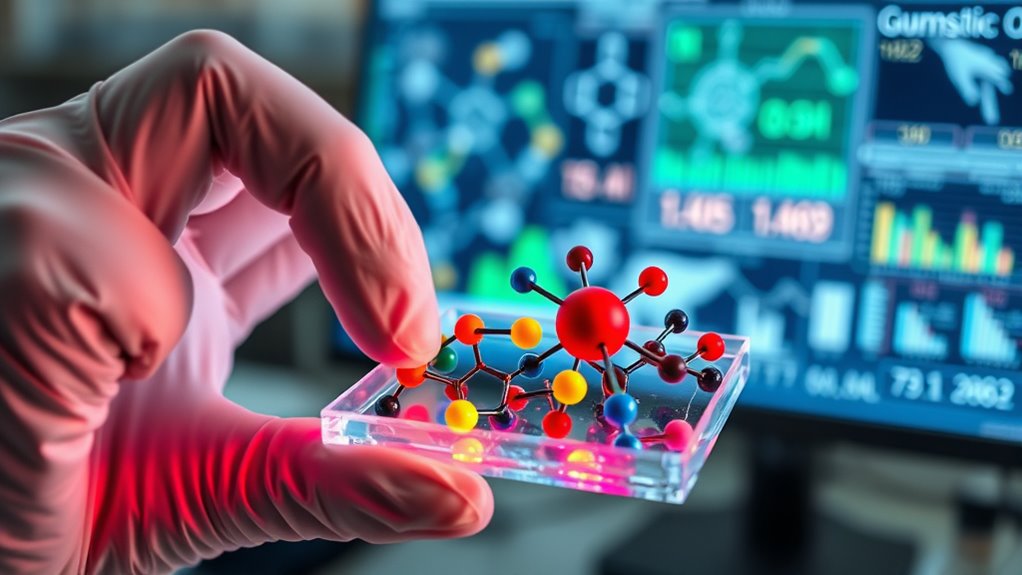
Medicinal chemistry plays a crucial role in optimizing drug candidates by refining their pharmacokinetic properties, such as absorption, distribution, metabolism, and excretion (ADME). You focus on modifying chemical structures to balance potency with favorable pharmacokinetics, which can improve efficacy and safety. Organic chemistry techniques are essential in synthesizing these structural modifications. Enhanced ADME properties help reduce toxicity and side effects by better controlling drug levels in your body. You may develop novel delivery systems like liposomes or nanoparticles to boost solubility and bioavailability. Structural modifications, including simplifying complex natural products or adjusting functional groups, aid in improving potency, selectivity, and drug-like behavior. Your goal is to create stable, reliable formulations that ensure consistent drug delivery and long-term stability, ultimately optimizing the therapeutic potential of your drug candidate.
Using Computers to Predict and Improve Drugs

Computers have revolutionized drug development by enabling you to predict and optimize candidate molecules efficiently. Structure-Based Drug Design (SBDD) uses 3D structures of targets like proteins to craft drugs that interfere with biological pathways.
Ligand-Based Drug Design (LBDD) relies on known ligands to find relationships that enhance drug properties. Virtual Screening allows you to sift through vast compound libraries quickly, identifying promising candidates.
Molecular Docking predicts how well drugs bind to targets, evaluating efficacy and specificity. Machine Learning models analyze data to forecast drug performance and guide modifications.
These computational techniques, such as molecular modeling and protein design, save time and cut costs, making drug discovery faster and more precise. They also enable you to tailor drugs for specific diseases and patient groups, advancing personalized medicine. AI in Business techniques are increasingly integrated into drug development processes to further improve efficiency and outcomes.
The Process of Developing and Testing New Drugs
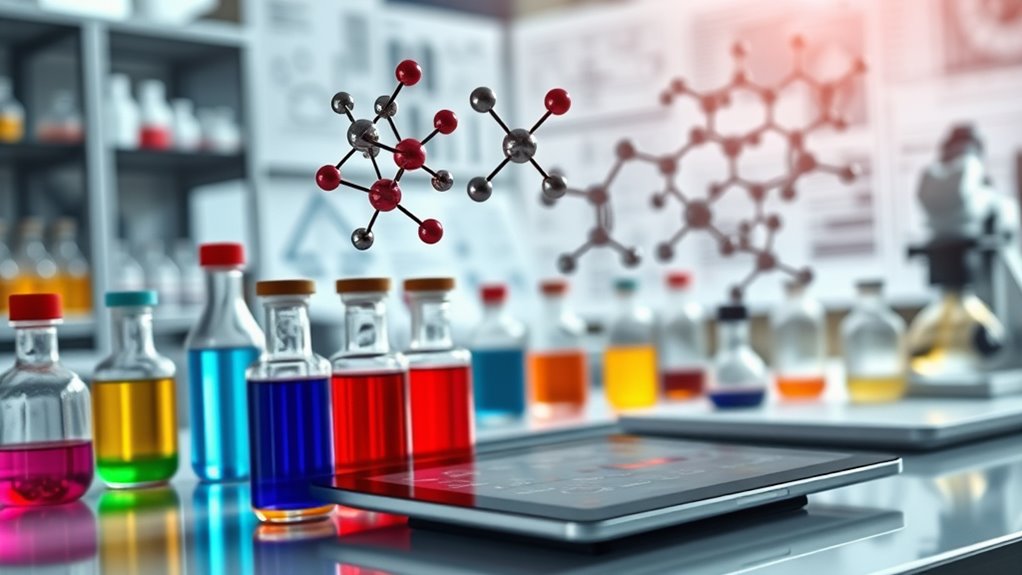
The development and testing of new drugs follow a systematic, multi-phase process designed to guarantee safety and effectiveness before reaching patients. First, you’ll identify a biological target involved in the disease, then screen many compounds to find those that interact effectively. You’ll evaluate properties like absorption, side effects, and interactions to select the best candidates. Next, in preclinical research, lab and animal studies assess safety, pharmacology, and drug behavior in the body, preparing for human trials. During clinical research, Phase I tests safety and dosage in volunteers, while Phase II and III evaluate efficacy and monitor side effects in larger patient groups. Finally, the FDA reviews all data, and post-approval monitoring continues to verify the drug’s safety and effectiveness in real-world use. Incorporating scientific methodology ensures a rigorous approach throughout the drug development process.
Overcoming Challenges in Drug Discovery
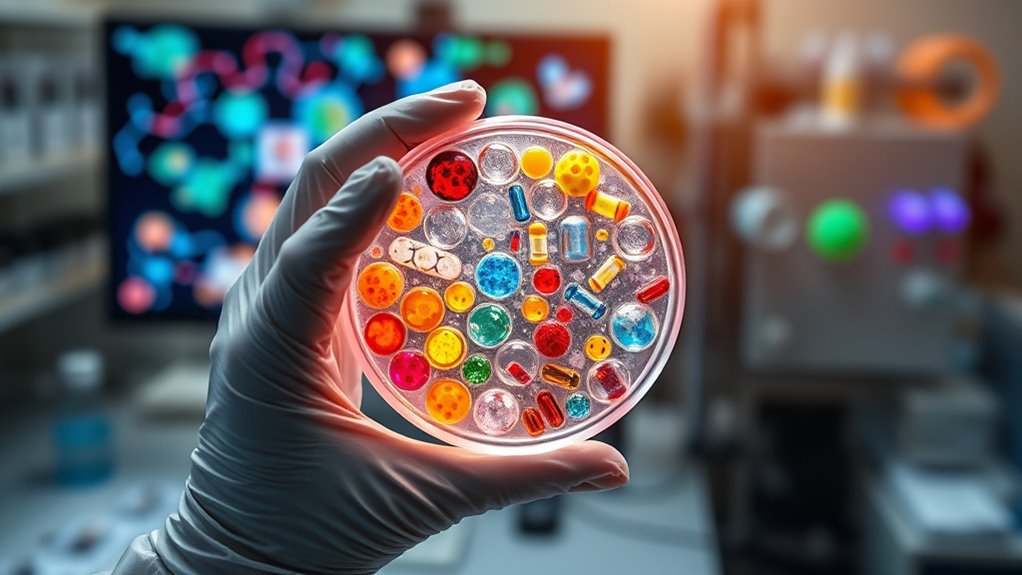
Advancements in drug development increasingly rely on new technologies to address persistent obstacles. You face challenges like rising costs, modeling limitations, and complex disease mechanisms. To overcome these, scientists leverage AI, machine learning, and computational tools that accelerate target identification and optimize drug candidates. These innovations help predict efficacy, manage off-target effects, and design multitarget drugs. A multidisciplinary approach, involving collaboration and diverse expertise, enhances problem-solving. Additionally, embracing polypharmacology through drug repositioning and rational design broadens therapeutic options. Chemical synthesis bottlenecks are tackled with innovative reactions and green chemistry, streamlining production. Recent advances in multi-target drug design, such as structure-based pharmacophore modeling and virtual screening, further enhance the ability to develop effective multitarget therapies. Here’s a quick overview:
| Challenge | Technology/Approach | Benefit |
|---|---|---|
| Rising costs | Data analytics, AI | Faster, cost-effective discovery |
| Model limitations | Computational modeling | Better prediction of interactions |
| Chemical synthesis hurdles | Green chemistry, novel reactions | More efficient compound creation |
Strategies for Effective Drug Delivery
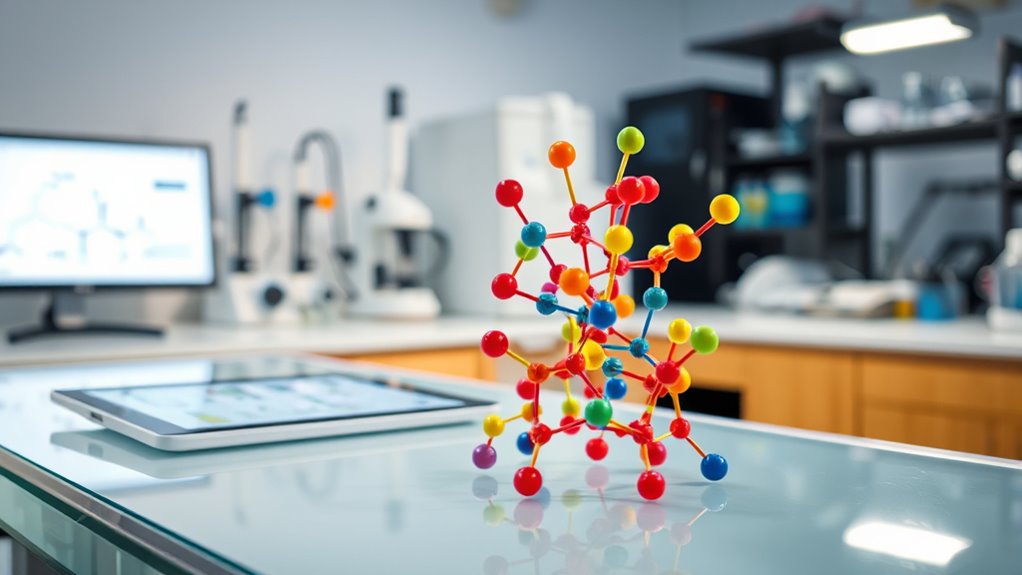
How can drugs effectively reach their target sites within the body? One key method involves using nanocarriers, which improve distribution by crossing biological barriers and enhancing transport through the vascular endothelium and tumor microenvironment.
Smaller nanoparticles increase permeability, helping targeted delivery. The Enhanced Permeability and Retention (EPR) effect allows drugs to passively diffuse into tumor tissues via leaky blood vessels.
Attaching ligands to nanoparticles enables active targeting of specific cell surface markers, reducing toxicity.
Stimuli-responsive systems release drugs in response to environmental cues like pH or temperature, providing controlled delivery.
These strategies help bypass biological barriers, improve localization, and minimize side effects, ensuring your medication reaches the intended site effectively, especially in complex tissues like tumors.
Designing Drugs With Specific Targets in Mind

Have you ever wondered how scientists craft medications that precisely target disease-causing biomolecules? They focus on specific biomolecules like proteins or mRNA that influence disease processes. To identify the best targets, they use methods like genomic sequencing, proteomic analysis, and CRISPR screening. These techniques help find molecules involved in disease and suitable for drug binding. Utilizing targeted approaches ensures that drug design is directed precisely where it needs to act, increasing efficacy and safety.
Future Directions in Medicinal Chemistry
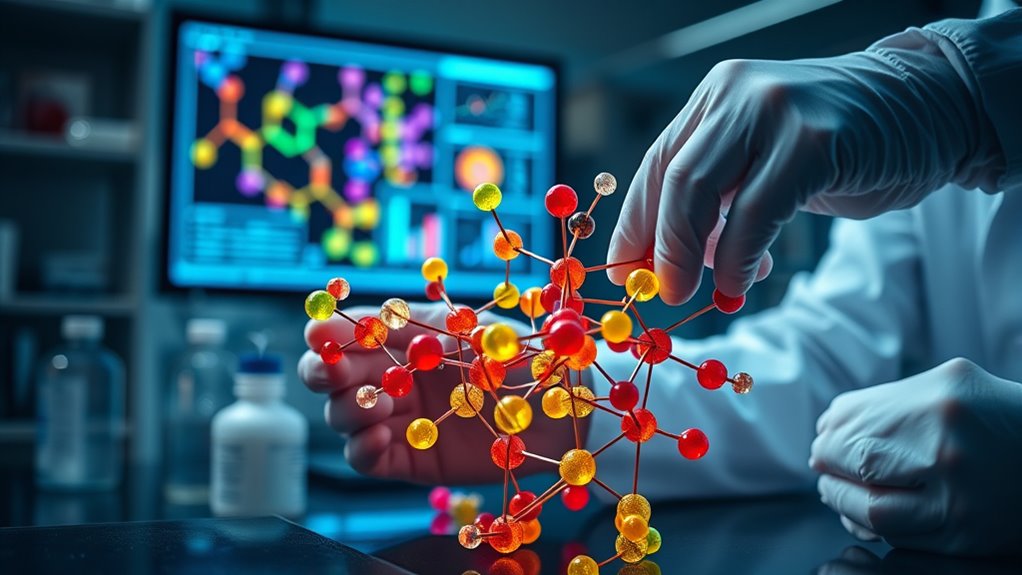
Emerging technologies are transforming medicinal chemistry by introducing innovative approaches that accelerate drug discovery and development. Advances in AI and machine learning now help you predict drug behavior more accurately, speeding up the process.
Synthetic biology enables you to engineer new pathways for producing drugs efficiently. Computational tools allow for simulation and interaction prediction, making design more precise.
Robotic automation streamlines high-throughput screening, enabling rapid evaluation of compounds. Personalized medicine platforms are paving the way for treatments tailored to individual genetic profiles.
Collaboration across disciplines, like biotechnology and genomics, fuels innovation. You’ll also see growth in therapeutic modalities such as gene editing, oligonucleotides, and CAR-T cells.
Additionally, understanding emotional support can enhance patient outcomes by addressing psychological well-being alongside physical health. These advances promise more effective, targeted therapies, ultimately transforming patient care and overcoming current treatment limitations.
Frequently Asked Questions
How Do Scientists Determine the Most Suitable Biological Target for a Drug?
You start by identifying disease-related molecules or pathways that could be influenced. Then, you use techniques like genetic screens, biochemical assays, or computational models to find proteins or genes vital for disease progression.
You validate potential targets through experiments, such as gene editing or binding studies, to guarantee they’re specific and relevant. This process helps you pinpoint the most promising biological target to develop effective, targeted drugs.
What Are the Main Differences Between Natural Products and Synthetic Drug Candidates?
You’ll find that over 50% of approved small-molecule drugs originate from natural products, highlighting their importance. Natural products have complex, diverse structures often derived directly from biological sources, offering broader target ranges.
In contrast, synthetic candidates are usually flatter, more rigid, and aromatic-rich, which can increase toxicity. Natural products tend to work holistically and have fewer side effects, while synthetics focus on specific pathways for quicker, targeted outcomes.
How Does Medicinal Chemistry Balance Drug Potency With Minimizing Side Effects?
You want to balance drug potency with minimizing side effects, so you focus on optimizing ADMET properties early on. By adjusting chemical structures, you improve receptor selectivity, ensuring the drug targets only intended sites.
You also fine-tune dosage through dose-response calibration and consider tissue-specific receptor expression. Monitoring metabolites and off-target interactions helps you reduce adverse effects, creating a safer, more effective medicine without sacrificing therapeutic strength.
What Advancements Are Shaping the Future of Personalized Medicine in Drug Design?
You should know that advancements like genomic research, pharmacogenomics, and biomarker discovery are transforming personalized medicine.
You can leverage genetic profiling to tailor treatments, improving efficacy and reducing side effects.
Digital health tools, like wearable devices, enable real-time monitoring, allowing you to adjust therapies promptly.
These innovations help identify responsive patient groups, streamline drug development, and make personalized approaches more precise, efficient, and accessible for everyone.
How Do Regulatory Agencies Evaluate the Safety of New Medicinal Compounds?
Regulatory agencies evaluate the safety of new medicinal compounds by reviewing data from preclinical and clinical studies. You submit toxicity, pharmacokinetics, and efficacy results for assessment.
Agencies analyze adverse event reports, monitor ongoing safety through pharmacovigilance, and identify safety signals.
They then weigh the benefits against risks, requiring additional studies or label updates if needed.
Continuous post-marketing surveillance helps guarantee long-term safety and protects public health.
Conclusion
So, after all this, you might think designing drugs is straightforward. But as you now see, it’s a complex dance of science, guesswork, and high-tech wizardry. Ironically, creating medicines that save lives often involves precise mistakes and happy accidents. In the end, your journey through medicinal chemistry shows that even in a world driven by data and design, a little bit of chaos keeps the process interesting—and ultimately, effective.
